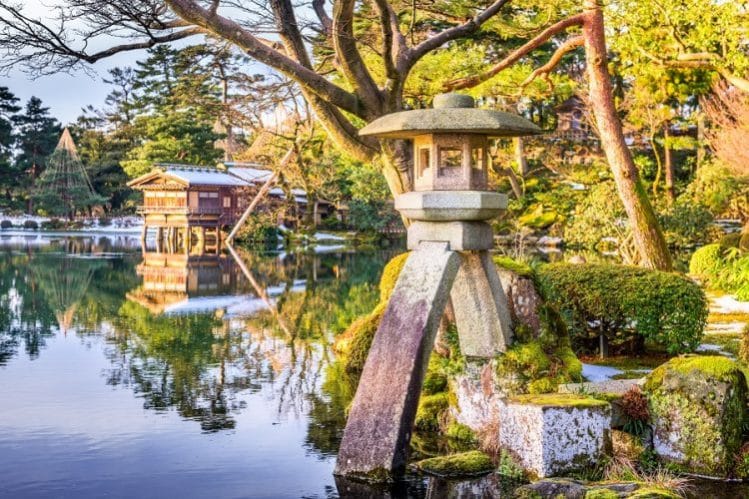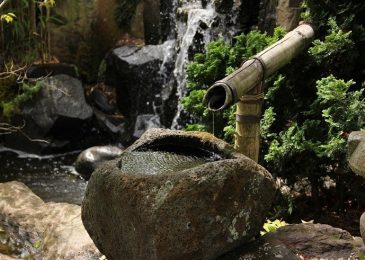The Japanese Garden – Concept And Design Elements

The Japanese garden is an integral part of Japanese culture, and gardening is seen as an activity to achieve not only a beautiful garden but also to achieve a feeling of peace and harmony.
This may be the only calming aspect that a person has in their daily, hectic lives. Japan is a highly overpopulated country, which means that many citizens do not have a large area for gardening. However, a good solution to this is to create a miniature garden using bonsai art.
Traditional Japanese gardens hold a place of fascination, unlike gardens of any other region of the world. These gardens go beyond the obvious aesthetic beauty. They speak not just of blooms and roots, but of spiritual transcendence.
In design, Japanese gardens are composed of symbolic and literal recreations of nature. These gardens are not created to “wow” the visitor like gardens of other cultures. The seemingly simple design invites us to look closer to find the complexity both within the garden and within our own minds and spirits. The subtlety is apparent and the underlying complexity can be breathtaking.
Everything in these gardens is made with a spiritual purpose. A Japanese garden is a quiet place for meditation or reflection. A zig-zag-designed bridge, for instance, ensures that the walker will take time to cross and that she will have an opportunity to contemplate herself and her surroundings. The inclusion of a Japanese maple tree, which changes colors dramatically through the seasons—culminating in a fiery crimson-orange during the autumn—prompts the visitor to think about the passage of time.
Read More: Best Buyer’s Guide to Garden Furniture
Basic Concepts Of A Japanese Garden
When one is creating the Japanese garden one must understand a few basic concepts. The main thing to remember is that all gardens that are authentic Japanese require three basic elements. These elements are water, stone, and some green.
The Japanese believe that water is equal to life. The water must also flow from east to west, just as the sun rises and sets. Stones are a critical piece of the garden because they act as a peace element.
What are Japanese Garden Concepts
Japanese garden concepts refer to the principles and design elements used in the creation of Japanese gardens. These concepts are influenced by Japanese culture and philosophy and are intended to create a peaceful and harmonious atmosphere that promotes contemplation and relaxation.
Some common Japanese garden concepts include Wabi-Sabi, which values imperfection and simplicity, Tsukiyama, which involves creating a miniature landscape using rocks, plants, and water features, and Karesansui, which is a dry garden style that emphasizes minimalism and the use of rocks and sand to represent natural elements.
Other concepts include Shakkei, which incorporates the surrounding landscape into the garden’s design, and Chaniwa, which is a tea garden designed specifically for the traditional Japanese tea ceremony.
Read More: Amazing Gardening Ideas Every Homeowner Should Consider Trying
Emphasis Is On The Rocks And Water

The stone is placed by humans when making the garden, but it must look as if it has been there for decades. Green is another element in the garden, but the emphasis is placed more on the rocks and water than on the greenery.
Now that one knows the basic elements needed for a Japanese garden, one must find out how to create one. Creating a bonsai tree garden based on the Japanese form can be learned from books, the internet, and even a nursery from which one can buy bonsai trees and bonsai supplies.
If one looks on the internet, then one can find a variety of bonsai books that teach one how to keep these delicate trees alive while keeping the idea of the Japanese art form intact.
The elements of the Japanese garden exhibit the strength and serenity of Japanese culture. One can learn many things by understanding how to create a garden based on the elements of bonsai.
No matter if one incorporates the bonsai art or if they leave it out, one thing is for sure; gardening is an art all to itself that can help a person to get back to nature and what is important in this life.
Japanese Garden Design – Simple Peacefulness
There are many different types of Japanese garden designs, but in general, it can be said that Japanese gardens are composed of symbolic and literal recreations of nature. Nature is ideal, and gardeners strive toward an accurate and respectful depiction of it.
These gardens are not created to impress the visitor with explosions of color like gardens of other cultures. In fact, a major aspect of Japanese garden design is the inclusion of “empty” space. The key to this type of home garden design is balance, and the empty space provides a “nothing” to balance the many “somethings.” The seemingly simple design invites us to look closer to find the complexity both within the garden and within our own minds and spirits. When one does take the time to explore the garden and all its meanings, it can be absolutely breathtaking.
Everything in these gardens is made with a spiritual purpose. A Japanese garden is a quiet place for meditation or reflection.
There are three traditional types of Japanese gardens.
-
Tsukiyama Gardens
The name translates as “hill garden.” These gardens are designed to give the impression of a great expanse of land, though most are relatively small. Small bodies of water, both moving (streams, waterfalls) and still (ponds), call attention to the dynamism of nature and of life. Along with the water, hills, stones, trees, flowers, bridges, and paths are used to create a miniature reproduction of natural scenery. It is said that the purpose of Tsukiyama gardens is to represent the natural world boiled down to its essential elements
Some Tsukiyama gardens represent actual famous landscapes of Japan or China.
Tsukiyama gardens vary in the way they are viewed. Traditionally, they have been designed to have a single viewpoint, such as the veranda of a temple. Many smaller gardens are still set up in this way. But larger and more modern Tsukiyama gardens have one or multiple paths that take the visitor around the garden.
Read More: Advantages Of An Online Home & Garden Shop
-
Karesansui Gardens
Karesansui gardens reproduce natural landscapes in a more abstract way by using stones, gravel, sand, and sometimes a few patches of moss for representing mountains, islands, boats, and, perhaps most importantly, bodies of moving water. Karesansuigardens are strongly influenced by Zen garden Buddhism and used for meditation: they are viewing gardens, not intended to be entered but contemplated from a set location. The use of sand or gravel to symbolize water is central to the karesansui garden, the raking of gravel round stones resembling the ripples caused by rocks in the water.
In karesansui gardens, an emphasis is placed on the beauty of “empty” space. Often, there will be little adornment aside from the small pebbles raked into waves and a few larger stones. This “emptiness” is designed to give the viewer a feeling of great calm.
-
Chaniwa Gardens
Chaniwa gardens are designed for the tea ceremony. In this ceremony, called the sado, the drinking of tea symbolizes the recognition that every human encounter is a singular and unique occasion that never can or will recur again exactly. In many cases, the chaniwa is not really a full-fledged garden like the other types, but rather a narrow path of stepping stones leading up to the chashitsu, or tea room. The placement of the stepping stones that lead to the main tea room is a hallmark feature of this garden type. Chaniwa gardens also feature stone lanterns and stone water basins, called tsukubai, where guests purify themselves before partaking in the tea ceremony.
Chaniwa gardens are designed to give a feeling of detachment from the rest of the world so that the participants can concentrate solely on the tea and the others participating in the ceremony.

Japanese Water Gardens – Fluid Tranquility
Traditional Japanese gardens come in many varieties. One of the most important and intriguing aspects of Japanese gardens is the use of water. Ponds, streams, and waterfalls all have a place in many traditional gardens. Even in karesansui, or “dry gardens,” sand and pebbles are raked to represent water moving around islands.
Japanese gardens are places for quiet contemplation. Even if they are mere yards away from the rest of society, they are meant to be apart from the bustle of the hectic world. Water is important in that it has a calming effect on the viewer and adds to the feeling of seclusion.
Keeping it Real
In a Japanese garden, all water sources should appear to be an organic part of the surroundings. Man-made streams are designed with curves and irregularities to recreate the cut banks and point bars of naturally flowing bodies. You will never find a square pond in a traditional Japanese water garden, just as you will never find one occurring naturally. Because of this need for a natural appearance, there are no fountains in traditional gardens, but small waterfalls are fairly common.
Lanterns are often placed beside prominent bodies of water—be it a pond or a stream—in a garden. This juxtaposition of water and fire creates the yin and yang (actually the in and yo, in Japanese), an important idea in Japanese culture involving the balancing of opposites to create harmony.
Many gardens will employ a dry pond or stream. Dry Ponds and streams have as much impact as the ones filled with water. After all, the water, whether real or symbolized with sand, rocks, and pebbles, is itself simply a representation of larger aspects of the nature around us and the souls within us.
Something Fishy

In many Japanese ponds, decorative fish, called Koi, are kept. Koi are a domesticated variety of carp, which originated in China but has become an important part of Japanese life. While Koi are related to the common variety of goldfish, they are not simply “big goldfish,” as many people think upon seeing them. The word “Koi” refers to all varieties of fish: the bright orange, the dull gray-brown, and the spotted. The Japanese word “Nishikigoi” refers more specifically to the decorative orange type. Koi and images of Koi are traditionally considered to be symbols of luck and good fortune.
The Dynamic World
Water symbolizes purity and the fluidity of life. Along with plants and trees which change in appearance with the seasons, water is used in gardens to remind us of the relentless passage of time.
A bridge crossing the water denotes a journey. Bridges are symbolic of moving from one world into another, a theme found throughout Japanese art. A common sight in traditional Japanese water gardens is a zig-zag-designed bridge. This design ensures that the walker will take time to cross and that she will have an opportunity to contemplate herself and her surroundings.
Cleanliness
The meaning of water in Japanese culture cannot be overstated. Ancient Japanese beliefs held that the gods resided within nature: in the trees, earth, water, etc. Bathing in a natural body of water was as close as one could get to the gods.
Water brings with it health, wealth, and wisdom. It also works to cleanse people of evil, bad luck, and the dirt of day-to-day living, spiritually speaking. There are many water rituals conducted even in contemporary Japanese culture. Inside every Shinto shrine is a basin of water that worshippers use to cleanse their mouths and hands before prayer begins.
A Japanese-style water garden can work in almost any environment, no matter whether you have a few acres or just a few square feet. The key is balance and not letting one aspect of the garden overwhelm the others.
Japanese Rock Gardens – Nirvana of gardening

Japanese rock gardens use specifically shaped stones to represent, in an abstract way, both physical elements of nature and aspects of the human mind and spirit. The only things besides rocks in a karesansui garden, as they are known traditionally, are tufts of moss that grow between.
The stones, gravel, sand, and these few patches of moss are arranged to represent mountains, islands, boats, and, perhaps most importantly, bodies of moving water.
Karesansui gardens are strongly influenced by the tenets of Zen Buddhism. They are viewing gardens, not intended to be entered but to be contemplated from a set location. The use of sand or gravel to symbolize water is central to the karesansui garden, the raking of gravel round stones resembling the ripples caused by rocks in water or the way water ripples as it laps up on the shores of islands.
In karesansui gardens, an emphasis is placed on the beauty of “empty” space. Often, there will be little adornment aside from the small pebbles raked into waves and a few larger stones. This “emptiness” is designed to give the viewer a feeling of great calm.
Along with the sand and small pebbles in the garden, there are normally a number of larger stones that impact the energy of the space.
Body Stone
The body stone, or Taidoseki, is an upright vertical stone that can be symbolic of a person or god. It should be close to even in diameter from the top to the bottom, with the base only slightly wider. The body stone is placed near the rear of the garden and is key in determining the flow of the garden.
Heart Stone
The Heart stone, or Shintaiseki, is a wide, flat stone, similar to a stepping stone. This stone is used to connect and harmonize the different elements in and around the garden: the stones and sand, as well as the land and water in the surrounding landscape.
Soul Stone
The soul stone is low and vertical, with a wide base and a tapered top. Known as Reishoseki in Japanese, this is perhaps the most important stone in the garden. The Guardian stone or Shu go seki, is usually low and vertical.
Branching Stone
The branching stone (Shigyoseki) is the only stone in the garden with a flat top that is wider than the base. This stone ties together the horizontal and vertical stones while it also draws together the stones with the branches of trees. This is a difficult stone to select; if the stone is not perfectly balanced, it can give an impression of instability to the entire garden.
Ox Stone
The ox stone, or Kikyakuseki, is, in height, between the heart stone and the branching stone. One end of the stone is higher than the other. This stone should be placed in the foreground; it acts to unify the other stones.
Along with these principle stones, there are also less prominent ones called helping stones. These rocks are fairly nondescript and hold no specific significance individually. They are normally grouped together in threes or fives.
While you are collecting and arranging these rocks in your rock garden, you should also keep in mind that there are stones to avoid.
The diseased stone is one with a misshapen or withered top. The dead stone is a vertical stone that is used as a horizontal, or vice versa. The pauper stone is one that has no relation to the other stones in the garden. You should also be careful to avoid any rocks that have been obviously cut or broken; all the stones in your garden should have been shaped by nature, and never by a man.
One of the most famous rock gardens in Japan is in Kyoto, at the Ryoanji temple. This garden is thirty meters long and ten meters wide and contains no plants.
Read More: Best Japanese Garden Tools










Great advice on how you should consider using rocks and natural fauna as a part of your garden’s focal point. I never knew that this could evoke a natural garden aesthetic that people usually love. Since my uncle is interested in remodeling his garden, perhaps finding an excavation expert can help him achieve this plan of his in the future.
Wow, I never knew that Japanese gardens use stones, sand, and greenery to attain an aesthetic everyone loves to see. My friend is interested in creating a recreational spot around his backyard. Maybe he should consult a landscape designer for this plan of his someday.